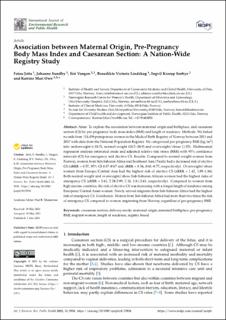| dc.contributor.author | Jatta, Fatou | |
| dc.contributor.author | Sundby, Johanne | |
| dc.contributor.author | Vangen, Siri | |
| dc.contributor.author | Lindskog, Benedikte V | |
| dc.contributor.author | Sørbye, Ingvil Krarup | |
| dc.contributor.author | Owe, Katrine Mari | |
| dc.date.accessioned | 2021-06-26T09:42:47Z | |
| dc.date.available | 2021-06-26T09:42:47Z | |
| dc.date.created | 2021-06-01T10:42:13Z | |
| dc.date.issued | 2021-06-01 | |
| dc.identifier.citation | International Journal of Environmental Research and Public Health. 2021, 18 (11), 1-16). | en_US |
| dc.identifier.issn | 1661-7827 | |
| dc.identifier.uri | https://hdl.handle.net/11250/2761445 | |
| dc.description.abstract | Aims: To explore the association between maternal origin and birthplace, and caesarean section (CS) by pre-pregnancy body mass index (BMI) and length of residence. Methods: We linked records from 118,459 primiparous women in the Medical Birth Registry of Norway between 2013 and 2017 with data from the National Population Register. We categorized pre-pregnancy BMI (kg/m2) into underweight (<18.5), normal weight (18.5–24.9) and overweight/obese (≥25). Multinomial regression analysis estimated crude and adjusted relative risk ratios (RRR) with 95% confidence intervals (CI) for emergency and elective CS. Results: Compared to normal weight women from Norway, women from Sub-Saharan Africa and Southeast Asia/Pacific had a decreased risk of elective CS (aRRR = 0.57, 95% CI 0.37–0.87 and aRRR = 0.56, 0.41–0.77, respectively). Overweight/obese women from Europe/Central Asia had the highest risk of elective CS (aRRR = 1.42, 1.09–1.86). Both normal weight and overweight/obese Sub-Saharan African women had the highest risks of emergency CS (aRRR = 2.61, 2.28-2.99; 2.18, 1.81-2.63, respectively). Compared to women from high-income countries, the risk of elective CS was increasing with a longer length of residence among European/Central Asian women. Newly arrived migrants from Sub-Saharan Africa had the highest risk of emergency CS. Conclusion: Women from Sub-Saharan Africa had more than two times the risk of emergency CS compared to women originating from Norway, regardless of pre-pregnancy BMI. | en_US |
| dc.description.sponsorship | This study is part of the MiPreg study. | en_US |
| dc.language.iso | eng | en_US |
| dc.publisher | MDPI | en_US |
| dc.relation.ispartofseries | International Journal of Environmental Research and Public Health;volume 18, issue 11 | |
| dc.rights | Navngivelse 4.0 Internasjonal | * |
| dc.rights.uri | http://creativecommons.org/licenses/by/4.0/deed.no | * |
| dc.subject | Caesarean sections | en_US |
| dc.subject | Delivery mode | en_US |
| dc.subject | Maternal origins | en_US |
| dc.subject | Maternal birthplaces | en_US |
| dc.subject | Migrant women | en_US |
| dc.subject | Residence lengths | en_US |
| dc.title | Association between Maternal Origin, Pre-Pregnancy Body Mass Index and Caesarean Section: A Nation-Wide Registry Study | en_US |
| dc.type | Peer reviewed | en_US |
| dc.type | Journal article | en_US |
| dc.description.version | publishedVersion | en_US |
| dc.rights.holder | © 2021 by the authors. | en_US |
| dc.source.articlenumber | 5938 | en_US |
| cristin.ispublished | true | |
| cristin.fulltext | original | |
| cristin.qualitycode | 1 | |
| dc.identifier.doi | https://doi.org/10.3390/ijerph18115938 | |
| dc.identifier.cristin | 1912989 | |
| dc.source.journal | International Journal of Environmental Research and Public Health | en_US |
| dc.source.volume | 18 | en_US |
| dc.source.issue | 11 | en_US |
| dc.source.pagenumber | 16 | en_US |
| dc.relation.project | Norges forskningsråd: 273328/2018. | en_US |

